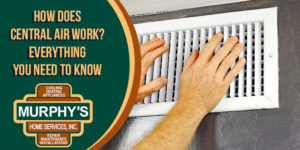
Upwards of 60% of American households use central air conditioning systems, making them the most popular option for homeowners who want to beat the heat.
However, even as they opt for central air conditioners over portable window units, many people don’t understand the magic of these systems’ cooling processes.
How does a central air conditioner transform the stagnant heat of a warm home into refreshing cool air? Here’s what you should know about how your unit works.
The Star Players of Your Central Air System
Your central air system is like a refrigerator for your home, and it uses a lot of the same cooling components as your fridge does. At its most basic level, these components allow it to gather heat and humidity in one place and transfer it to another.
Let’s get into the specific components that make this cooling process work.
Your central air system has two air conditioner coils that allow it to transfer this heat and cold, making them essential to its cooling abilities. First is the evaporator coil, which is located inside your home. This coil starts with cold liquid refrigerant inside of it, and it uses that refrigerant to absorb the heat from the air inside your house.
This refrigerant grows warm and turns to gas as it flows outside to the second coil, called the condenser coil, which sits outside of your house. The condenser coil then releases the heat that was absorbed inside your home, leaving your rooms nice and cool.
How Your AC Works
Everything starts with your thermostat. Whether you manually lower the temperature, or you’ve programmed a modern thermostat to kick on at certain points, your thermostat signals your AC to lower the air temperature of your home.
The air-handling unit of your HVAC will pull a flow of air through your air ducts. As the air travels, it will flow through any filters you have. These filters will in turn collect dust, pet dander, and pollutants that find their way into your home. This is why it’s so important to replace them often with high-quality options.
This air passes through your evaporator coil, which draws out the heat using the method mentioned above. As the cooling process continues, the refrigerant will also cool the air. Finally, your system will deliver cool air back to your home via your ductwork.
Keeping Your System Going
Now that you know a little more about the air conditioner parts of your central air system, it’s clear that your HVAC unit needs all of these components to work well together to keep running smoothly.
AC unit maintenance is vital to making sure that each part is clean, stays functional, and interacts properly with each of the components it connects with. To make sure your unit keeps you cool for longer, don’t hesitate to reach out to us for your maintenance needs.








